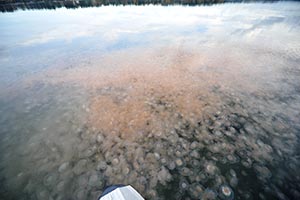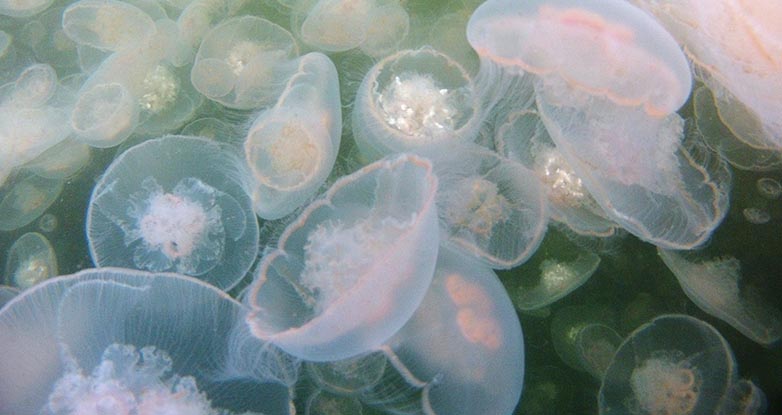Jellyfish in Puget Sound
Jellyfish "smacks," or mass aggregations, are common in Puget Sound during the summer. The number of jellyfish appears to be growing larger, and we are interested in learning why. We are monitoring water quality to help us understand what is changing.
These increases in jellyfish could be the result of changing water conditions and/or coincide with warmer conditions caused by a persistent patch of warm water, known informally as "the Blob," that came in from the Pacific Ocean in 2014 and drought conditions in 2015.
Jellyfish "smacks" are common in the summer
Jellyfish are common invertebrate animals that swim and float around Puget Sound. An aggregation of these creatures is called a mass or a "smack." Mass aggregations of the jellyfish Aurelia labiate, the moon jelly, can become so large that they can be seen from aircraft flying over Puget Sound. In fact, our scientists often spot them from the air during routine water quality monitoring.
Jellyfish may be increasing in South Puget Sound
Jellyfish biomass reached record levels in Budd Inlet and other finger inlets of South Puget Sound in the fall of 2014 and summer of 2015, coinciding with an unusually warm patch of water coming in from the Pacific nicknamed "the Blob" and with drought conditions in 2015. Salinity and temperature readings taken in Budd Inlet have given us a working hypothesis for why jellyfish are increasing.Jellyfish studies
We conducted a collaborative study with National Oceanic and Atmospheric Administration (NOAA) scientists to measure the quantity of animals in these jellyfish smacks in 2014. We examined each smack in color and density, as photographed by our float plane, and matched these results with jellyfish as counted by hand from a boat. We found that some patches may have millions of jellyfish. Learn more about our study on temperature and salinity.
Related links
Contact information
Mugdha Flores
Environmental Assessment Program Communications Manager
mugdha.flores@ecy.wa.gov
360-628-7692




